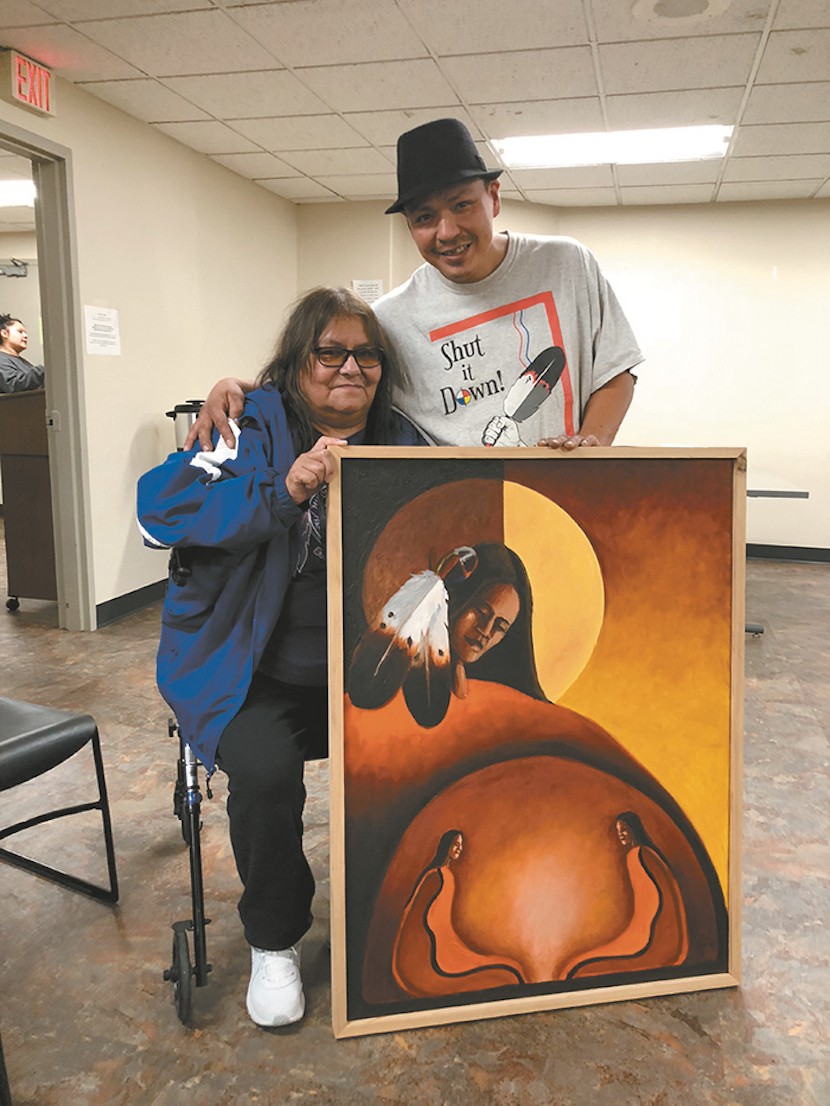
Brett Larson Inaajimowin Staff Writer
Artist Joe Gurneau unveiled a series of paintings on October 26 in front of an audience that could appreciate their value: the residents of the Four Winds Lodge treatment center in Brainerd, where the 12 paintings, representing each of the 12 Steps of Alcoholics Anonymous, will help bring inspiration and healing for years to come.
Joe, a Mille Lacs Band member, talked about each painting, beginning with the can of "Foul Lokto" on the painting of the first step. "I couldn't use the Four Loko can because of copy- right infringement," said Joe. "I was smart about that," he added, drawing laughter from his audience.
As he spoke about the paintings, a few themes emerged: the importance of the higher power or Creator, symbolized by the circles in several of the paintings; the significance of "we" in the first step (We came to believe...), showing the importance of community in recovery; and the "seed of sobriety," symbolized by the Ojibwe-style vine in the final painting.
"Whoever goes to treatment, whoever goes to AA, even if it doesn't take the first time, just know that the seed of sobriety has been planted, and it will never leave," said Joe. "That seed of sobriety will always blossom."
Afterwards Joe talked about his life on the streets of Minneapolis, where he was homeless on and off since he was 18. "Gang banging, drinking, and drugging was all I lived for," he said. He spent time in jail and treatment. His father, Joe Giizhik, taught him about sweat lodges and ceremonies. "But I was spiritually sick," Joe said.
The turning point came after he was diagnosed with cancer and told he only had a few months to live. "It was at that point where I said, 'I can continue to drink and drug, or I can clean up and start to live a good life.'" He put out tobacco, and a few months later was still alive. Doctors called it a miracle. "I believe the Creator gave me another chance at life," he said.
The final change came when his mom, Marilyn, drove to Minneapolis, "kidnapped" him (Joe's word), and took him to Mille Lacs. Joe moved into the halfway house where he met people who helped him turn his life around. "I took that opportunity to really reach out and ask for help," he said. "They took a chance on me, but I grasped onto those steps and sobriety, and I haven't let go. I found my sanity up here at Mille Lacs."
Joe's father, an artist himself, also introduced Joe to painting. Like sobriety, it was a seed that eventually blossomed.
"When I got here, I didn't have anything," he said. He would draw and paint at State of the Band or other community events and try to sell his work. When it got warm, he'd sit on the sidewalk in front of the government center. "Whatever I got, I spent on art supplies."
Rebecca St. Germaine used to see Joe and marvel at his talent, and before long, the two were talking about the 12 Steps series. It meant a lot to both of them to see Joe's work blossom at Four Winds. Rebecca, Four Winds Cultural Advisor Bobby Eagle, and Joe's halfway house roommate Colin Cash shared their memories and their pride in Joe's accomplishments at the unveiling.
Colin said he was inspired by Joe's presentation. "I remember when he was sitting in front of the government center; nobody saw the value in what he was doing. Something we forget is how much value we have as Anishinaabe people in recovery, and that was showed today. It made me cry to see how much value there is in my brother Joe and in everybody here."
Joe looked around at the result of his hard life, his hard work, his relationships, and his recovery. "When I pass on, these will all be here, helping out the newcomers," he said. "When they're having a hard time, they can look at where they started and where they can be. I'm grateful I got to share it all."
Photo: Joe Gurneau was joined by his mom, Marilyn, at the unveiling of Joe's artwork. Joe is grateful to his mom for "kidnapping" him and bringing him to Mille Lacs, where he was able to find healing.
The 12 Steps
Band member Joe Gurneau's series of paintings is based on the 12 Steps of Alcoholics Anonymous. See the captions beneath each painting for some of Joe's thoughts and feelings.
-
We admitted we were powerless over alcohol—that our lives had become unmanageable.
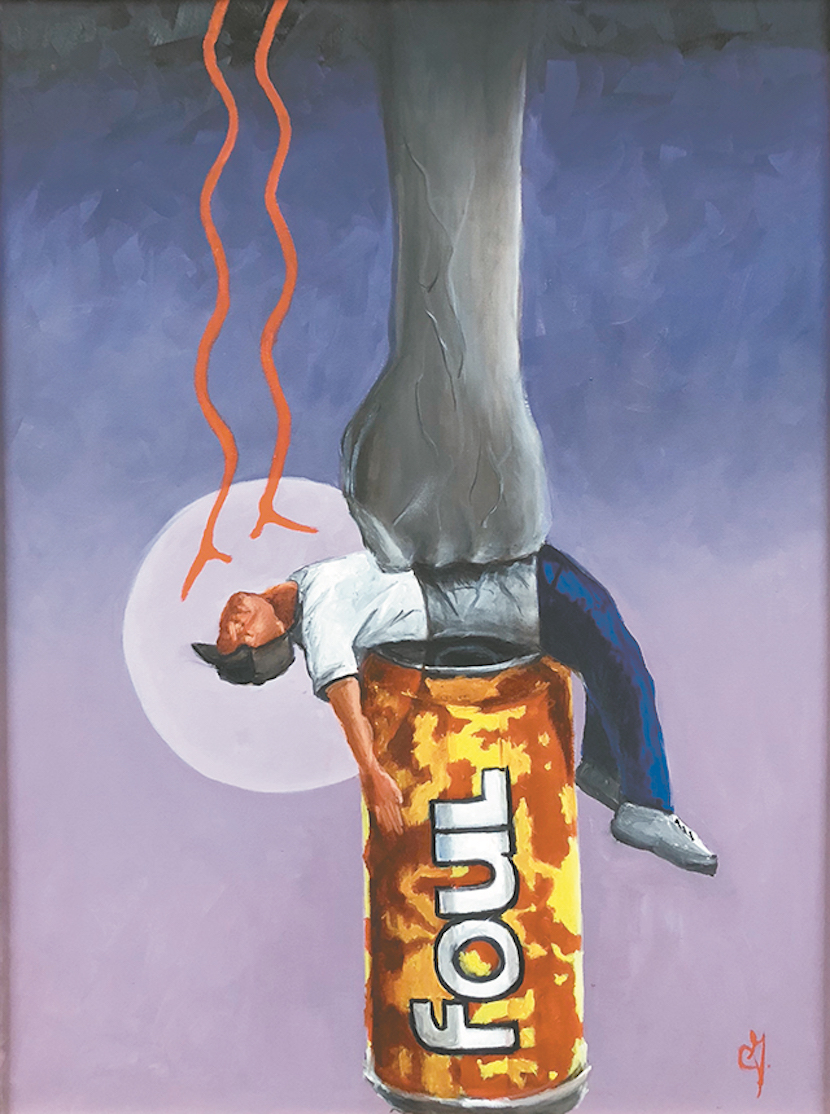
Step One — Powerless: "He's defeated — physically, spiritually, and emotionally. The lines coming down represent the prayers of the community, and the circle represents his higher power, who is there no matter where you are in life. The Creator never judges you." -
Came to believe that a Power greater than ourselves could restore us to sanity.
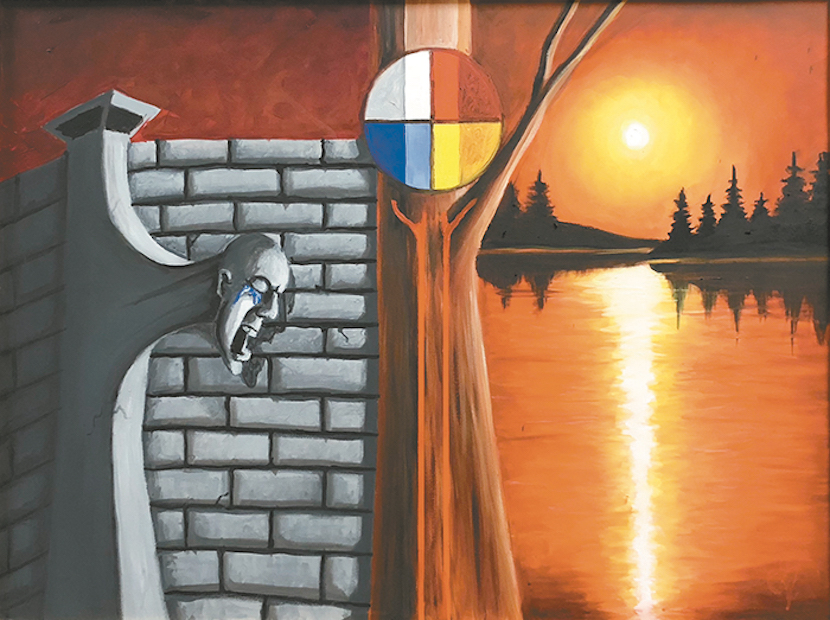
Step Two — Came to Believe: "You don't have to be locked up in a prison to be locked up.You could be locked up in your own mind. Notice how cold it is on the left side. The tree represents spiritual growth, and the right side, that's sanity. That's where you want to be." -
Made a decision to turn our will and our lives over to the care of God as we understood Him.
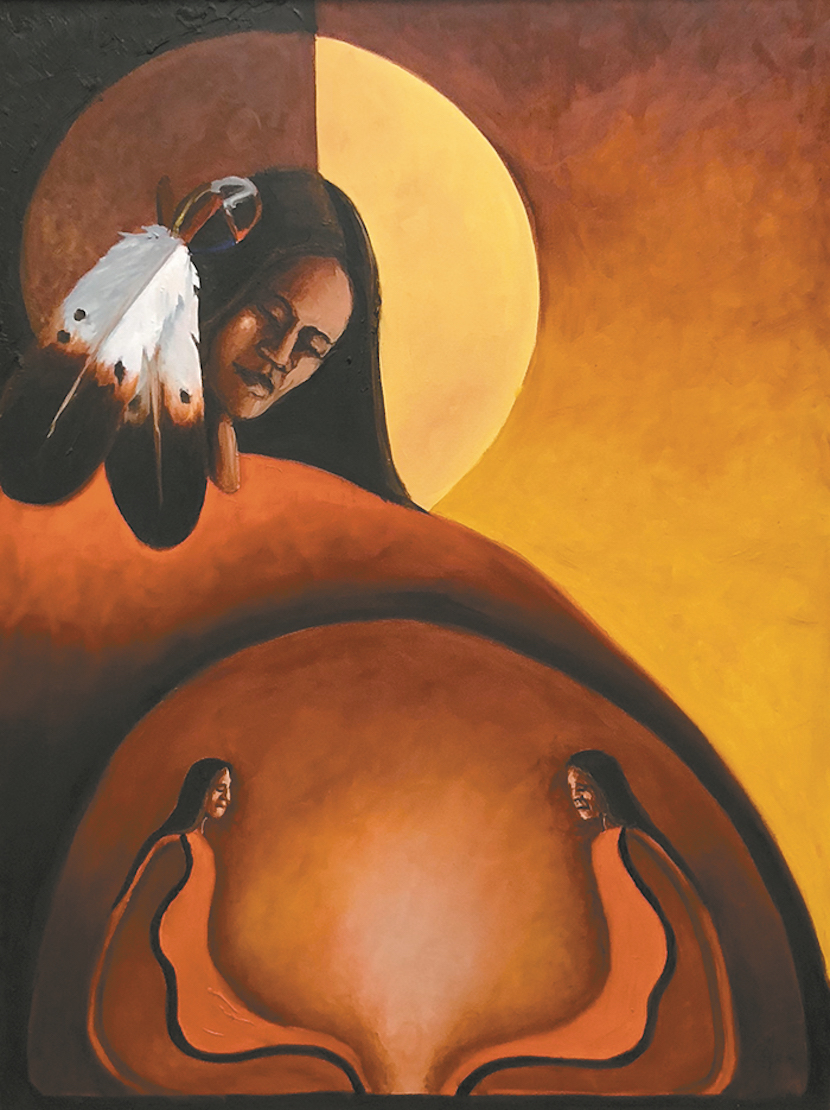
Step Three — Made a Decision: "This person is sitting down at a sweat lodge, being honest with himself, looking at how Mother Earth is always reminding us, and the circle represents the Creator, who is always with us in the dark times." -
Made a searching and fearless moral inventory of ourselves.
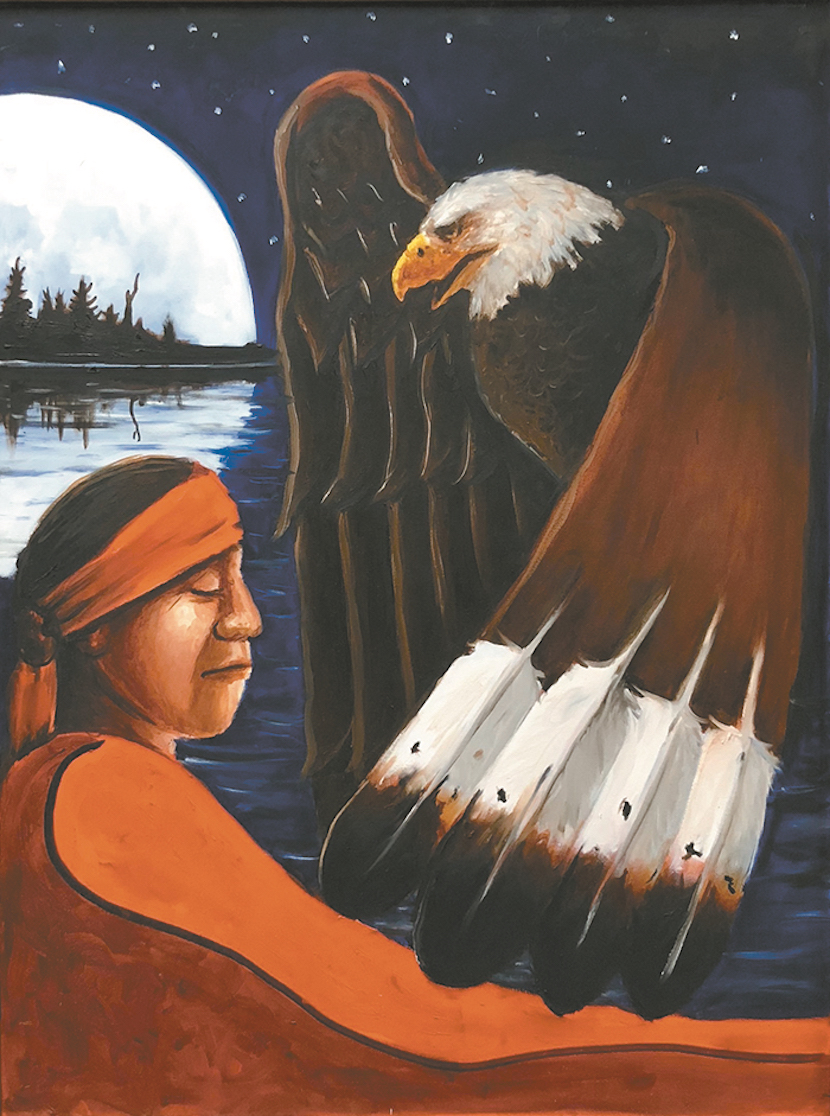
Step Four — Moral Inventory: "This person is sitting down and praying and being humble, reflecting on the hard times he caused his family and friends and community. The eagle, he carries the prayers up and blesses us back with his gifts." -
Admitted to God, to ourselves, and to another human being the exact nature of our wrongs.
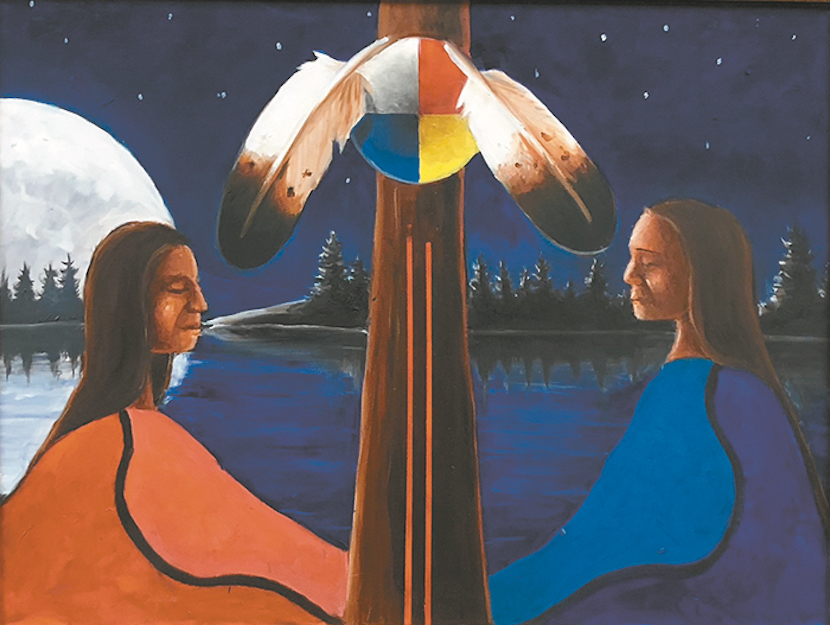
Step Five — The Nature of Our Wrongs: "This person is doing Step Five, being honest with himself with another human being, reflecting on all the harm he caused throughout his life." -
Were entirely ready to have God remove all these defects of character.
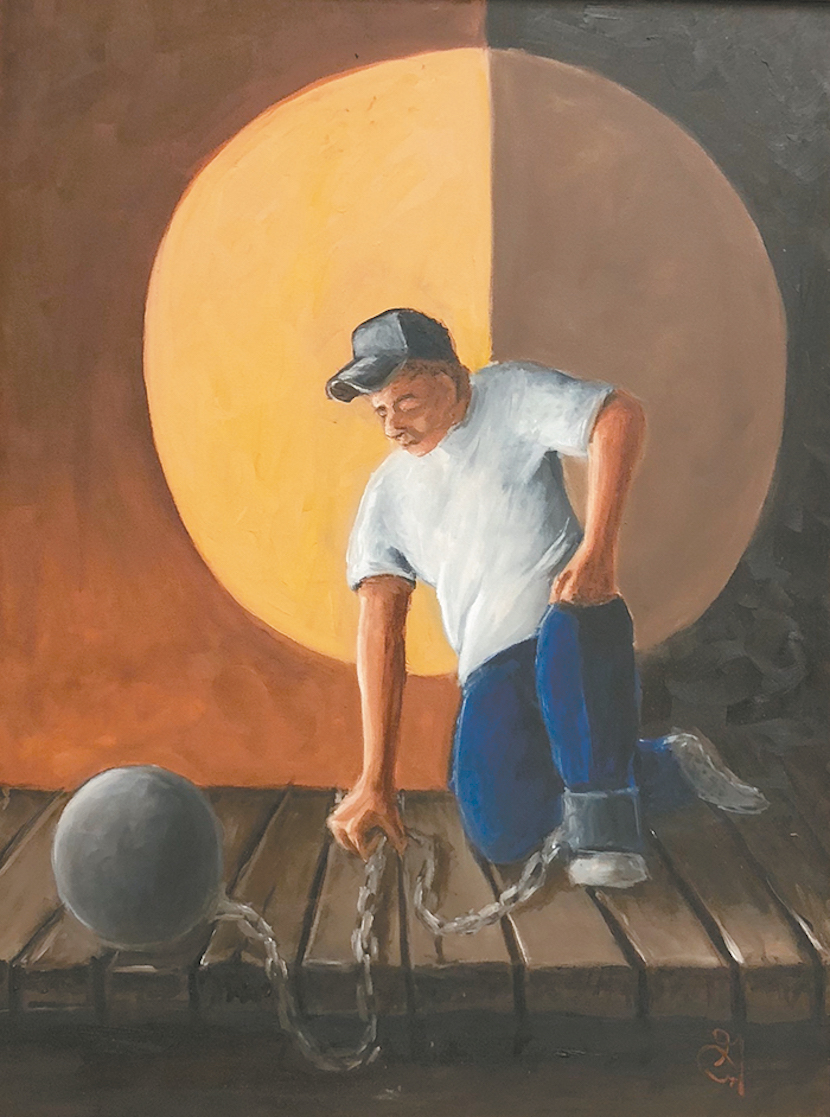
Step Six — Ready: "This person is ready to get up from all the chaos he went through, and the circle is the Creator, always behind him. The ball and chain are his defects of character, and he's ready to let them go." -
Humbly asked Him to remove our shortcomings.
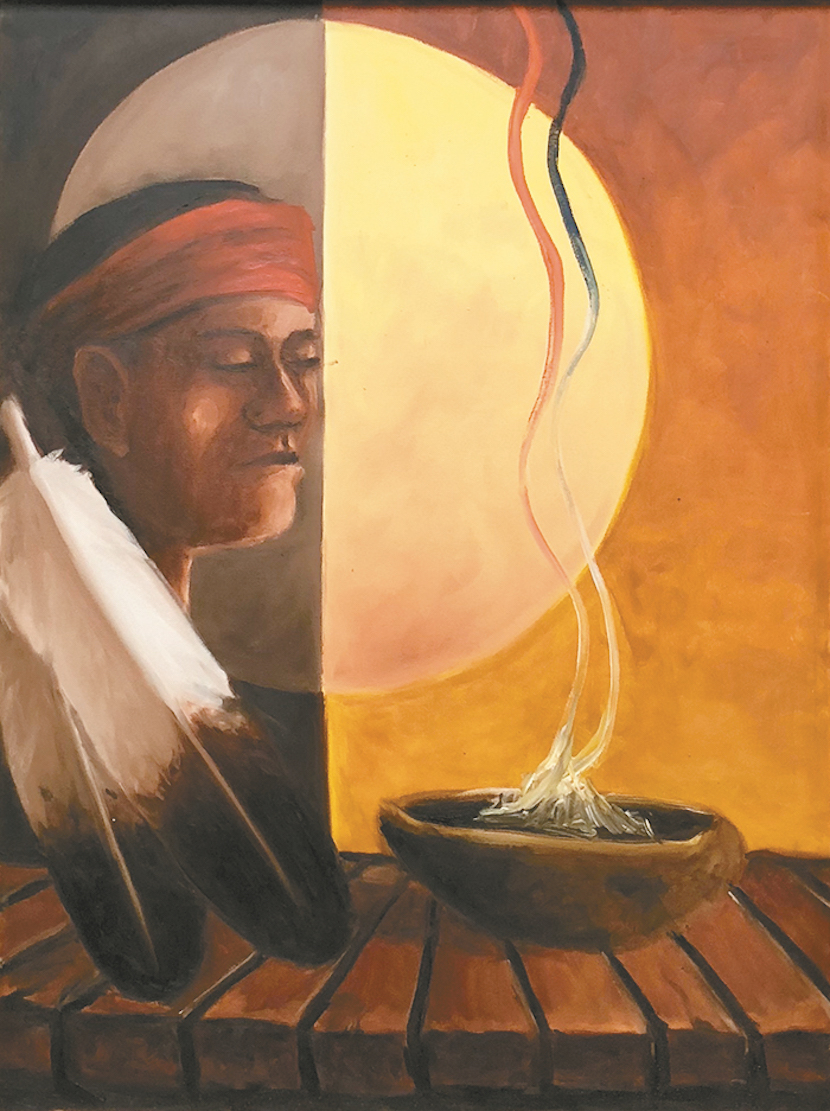
Step Seven — Humbly Asked: "The sage bowl represents prayers, humbly asking for help, and once again the Creator is still behind us, no matter where we are in life." -
Made a list of all persons we had harmed, and became willing to make amends.
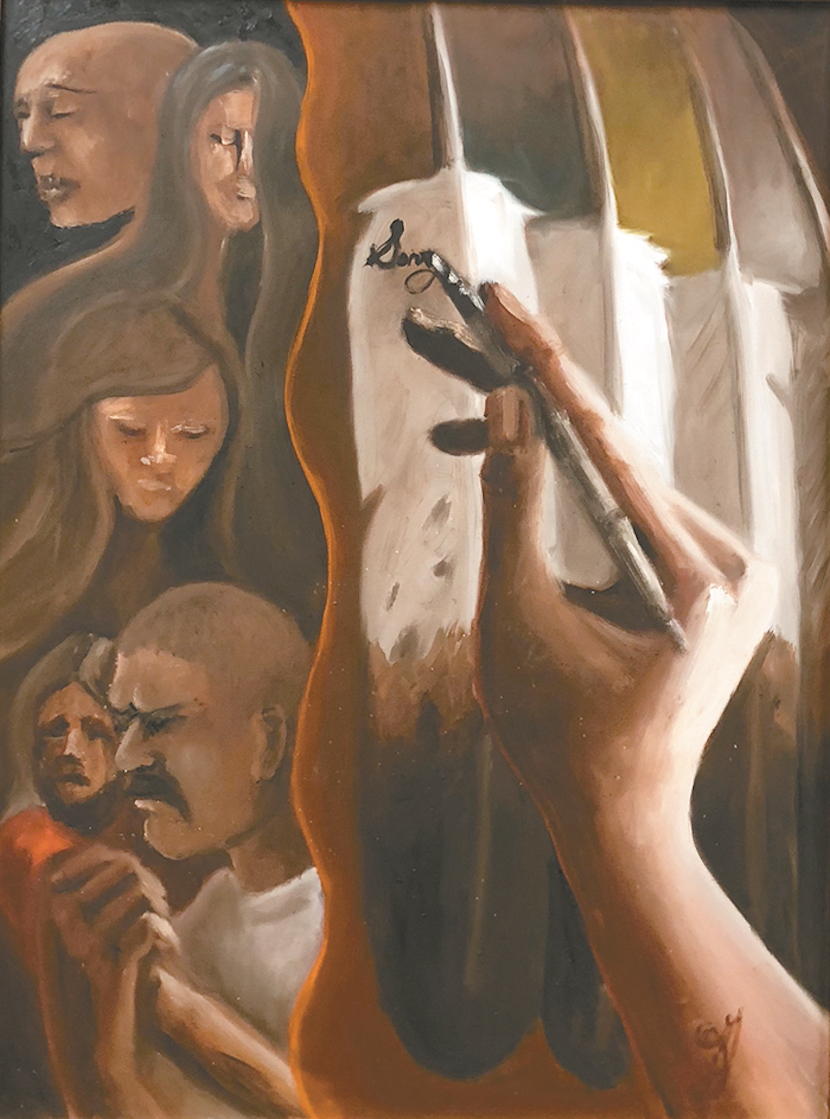
Step Eight — Willing: "These are all the people he's abused, and on the right is 'eagle paper.' The first word on the eagle paper is 'Sorry.' I love that eagle paper. I just made that up." -
Made direct amends to such people wherever possible, except when to do so would injure them or others.
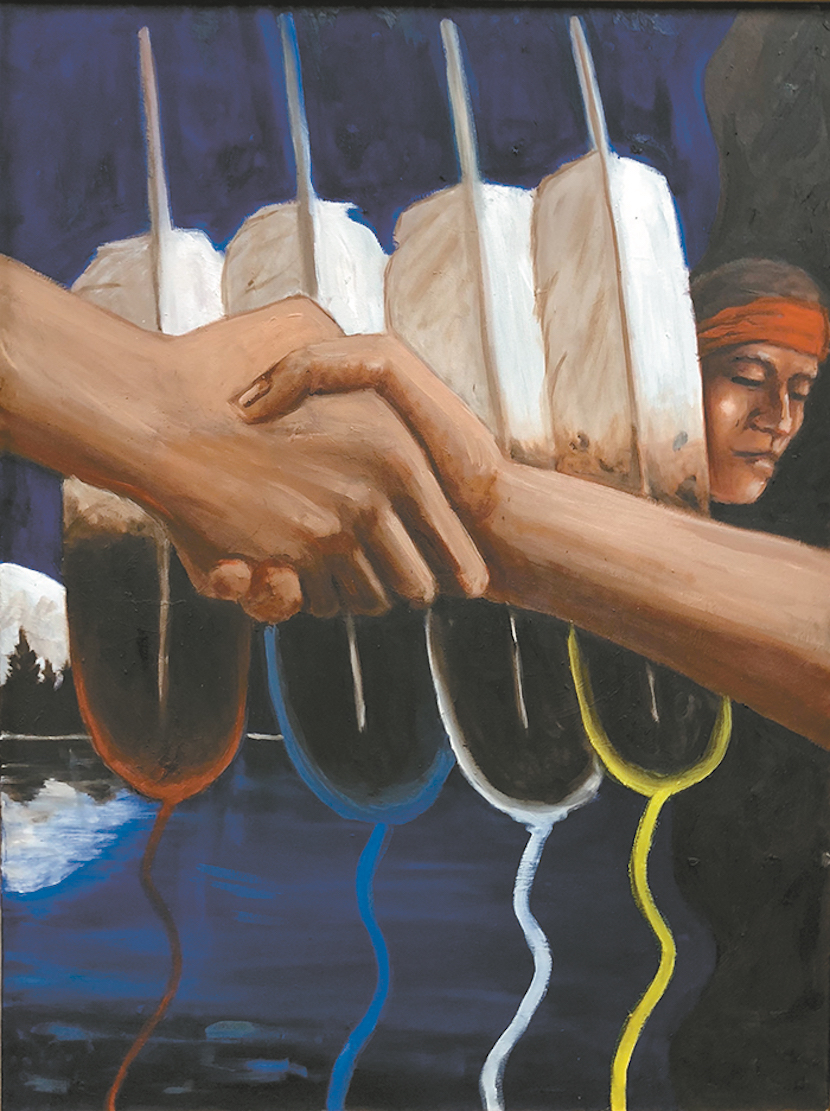
Step Nine — Making Amends: "When you get a chance to go see someone you may have hurt in the past, you shake hands and say, 'I'm sorry for the harm I caused you.' For those you'll never see, you say a prayer for them." -
Continued to take personal inventory and when we were wrong promptly admitted it.
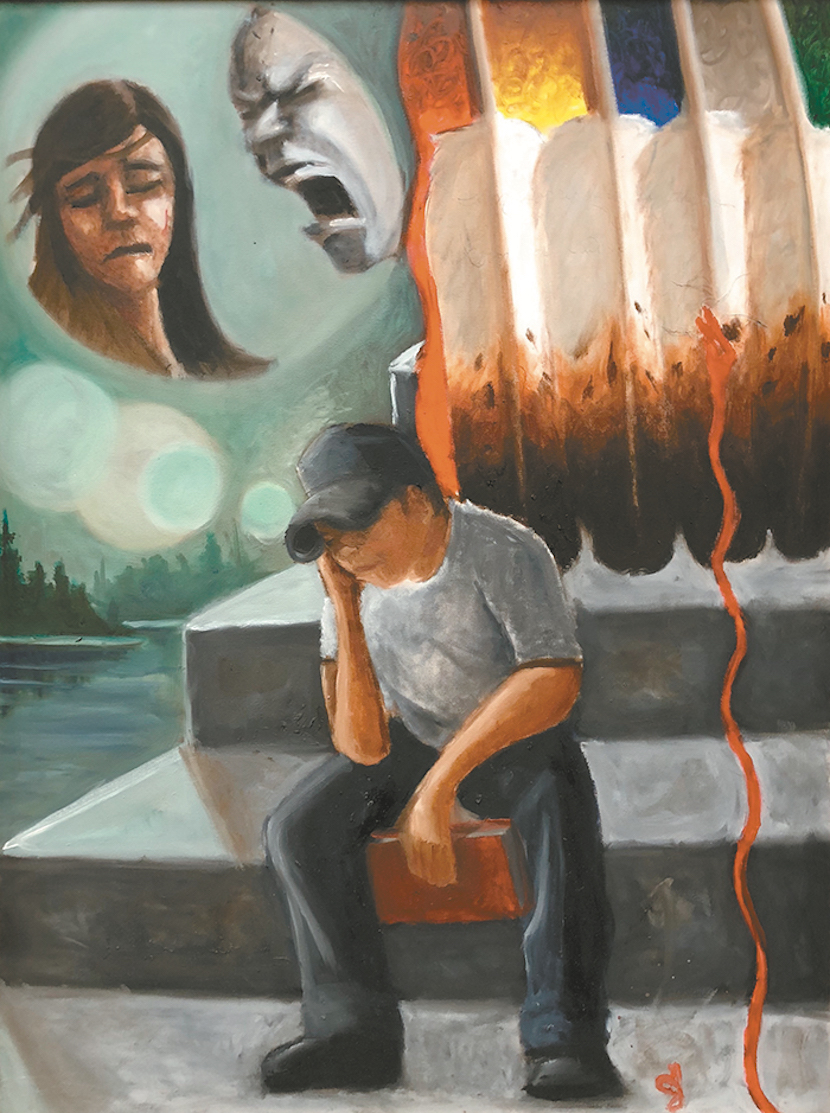
Step Ten — Promptly Admitted: "Notice he's on the steps. He's still working those steps. He's thinking about how he yelled at somebody. He's still writing on that eagle paper, taking responsibility for his actions." -
Sought through prayer and meditation to improve our conscious contact with God as we understood Him, praying only for knowledge of His will for us and the power to carry that out.
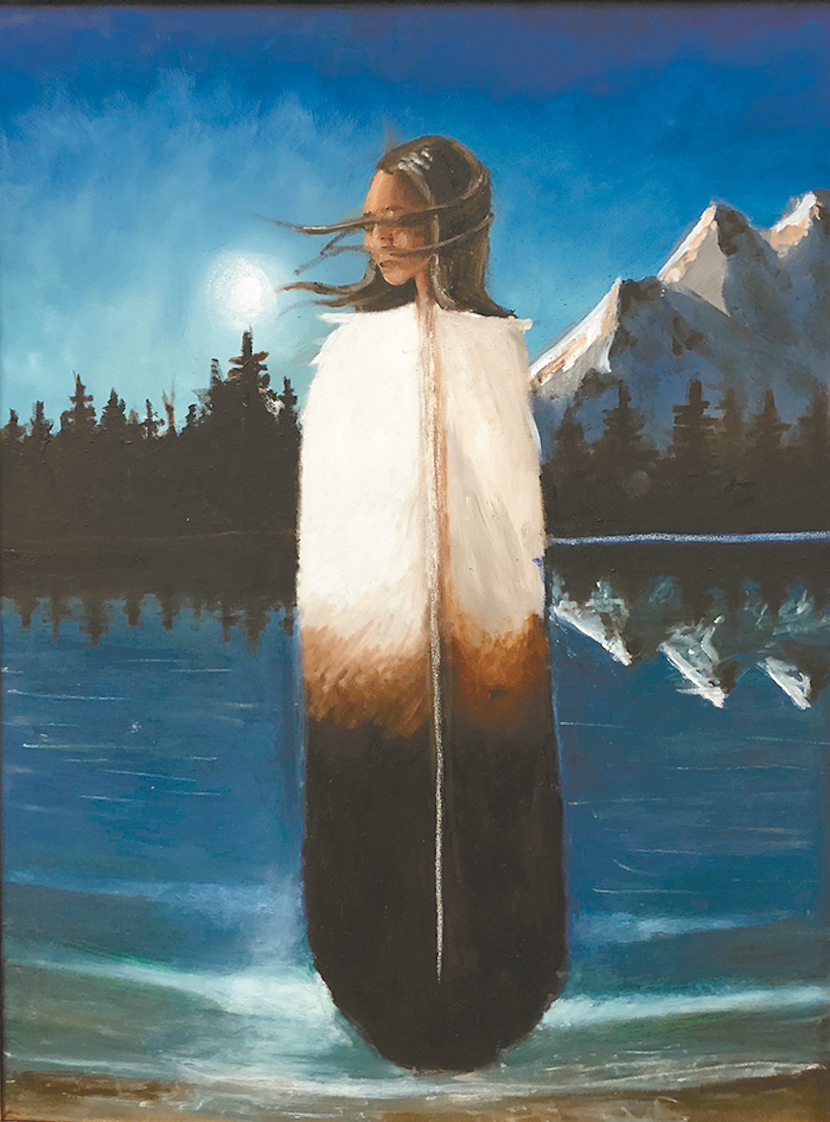
Step Eleven — Conscious Contact: "This is a simple painting, just remembering to pray and meditate. I believe when they made these steps, they were telling us to slow down." -
Having had a spiritual awakening as the result of these steps, we tried to carry this message to others, and to practice these principles in all our affairs.
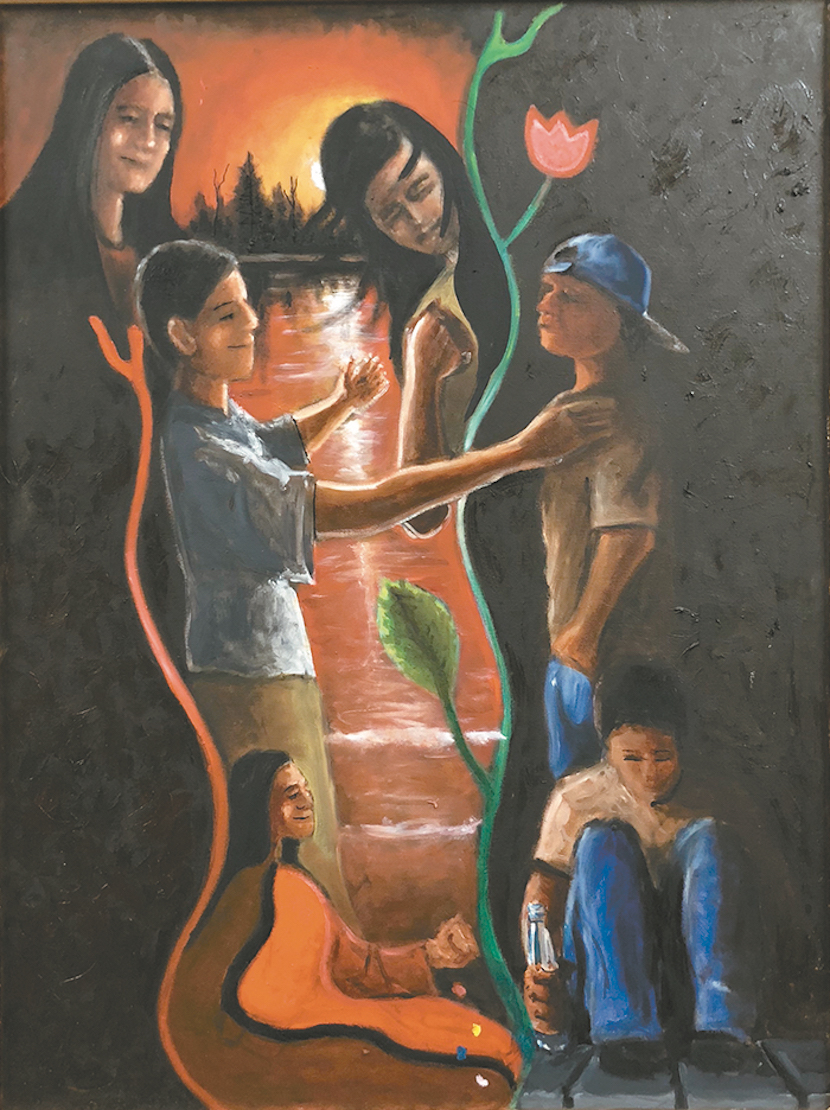
Step Twelve — Carrying the Message: "The dark side is on the right; they're lost and spiritually empty. The Ojibwe design represents the seed of sobriety. The people on the left, they're saying, 'Come on over to the light.'"